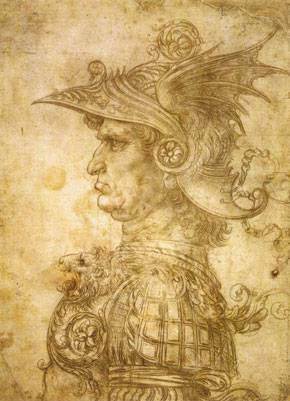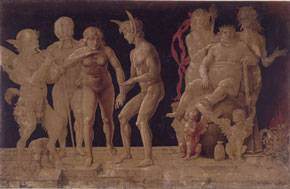
Leonardo da Vinci
‘Bust of a warrior’

Andrea Mantegna
‘Virtus Combusta (Virtue in flames)’
Fra Angelico to Leonardo: Italian Renaissance drawings at the British Museum This major exhibition, supported by BP, will bring together the finest group of Italian Renaissance drawings to be seen in this country for over seventy years
22 April – 25 July 2010
]]>
Source: British Museum
Drawn from the two foremost collections in the field, the Gabinetto Disegni e Stampe Uffizi in Florence and the British Museum, the display will chart the increasing importance of drawing during the period between 1400 and 1510, featuring 100 works by amongst others Fra Angelico, Jacopo and Gentile Bellini, Botticelli, Carpaccio, Leonardo da Vinci, Filippo Lippi, Mantegna, Michelangelo, Titian and Verrocchio. In addition, infrared reflectography and other non-invasive scientific analysis of the works will give fresh insights into the techniques and creative thinking of Renaissance artists as they experimented with a freedom not always apparent in their finished works.
In 15th century Italy a fundamental shift took place in the use of preparatory drawings. The starting point of 1400 marks the beginning of the Renaissance, which saw the development of perspective, an increased interest in classical forms and a greater focus on naturalism. The exhibition closes with the early drawings by Raphael and Michelangelo, prior to their departure to Rome and the unfolding of the High Renaissance. It was during the 1400s that artists began to make drawings as works of art in their own right, signifying the beginning of a wider appreciation of graphic works, which were beginning to be collected and preserved. This rising importance of drawing is evident in works such as Mantegna’s mordant allegory of human folly, the Virtus Combusta (Virtue in flames) or later examples of finished presentation drawings such Leonardo’s silverpoint Bust of a Warrior from the 1470s.
Nevertheless the majority of drawings in the exhibition are working studies, and as such were never intended to be seen outside the studio. Drawings allowed artists to practice and refine designs for paintings. It was during the 15th century that the stages of designing a painting from initial sketch to final design were worked out and this process remained in place until the modern age. Exploratory compositional studies were followed by detailed sketches of figures and important motifs, sometimes concluding with a same size drawing of the design known as cartoon. The exhibition will include the first surviving study for a panel painting: Lorenzo Monaco’s study in the Uffizi of around 1407 for the left-wing of his Coronation of the Virgin altarpiece from the National Gallery, London. The drawing and the related panel will be brought together for the first time.
The influence of classical art and architecture was a key factor in the emergence of a new approach by painters, sculptors and architects. A move towards realism, the representation of man and nature and the use of a linear perspective to create an illusion of the three dimensional form were the core elements of the Renaissance style, seen particularly in the album of finished drawings made by the Venetian painter Jacopo Bellini and in the works of his artistic rival Pisanello.
The importance of Leonardo in this period is reflected in the inclusion of ten drawings by him, including his celebrated pen study of a sun baked panoramic landscape that he precisely dated, 5 August 1473. This is the earliest landscape drawing in European art and the first documented work by Leonardo. The exhibition also examines how Leonardo’s extended stay in Milan affected the drawing style and practices of local artists, such as Boltraffio and Andrea Solario. Leonardo’s fresh naturalism and his desire to push the boundaries of painting inspired the generation of Michelangelo and Raphael to achieve what he had sketched out on paper but rarely delivered in terms of finished paintings.
Follow us on:
